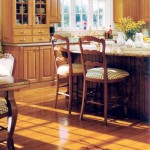The Confident Choice in Eco-Conscious Floors
From flooring and cabinetry to moulding and furniture, American hardwoods have been treasured for generations, and for good reason! They offer warmth, durability, luxury and design options that are unmatched by faux-wood products such as laminates and bamboo.
Recently, however, an abundance of green product labels and misinformation has led to confusion in the marketplace, and has everyone asking, “Are American hardwoods really a sustainable resource?” And, “Are the hardwood products I want for my home really green?” The answer to these questions is a resounding yes! And now, homeowners have assurance from the federal government that American hardwood products are not only beautiful, but truly green and sustainable.
Natural and sustainable
In recent years, the U.S. Congress passed resolutions that officially recognized that the American hardwood industry sustainably manages an environmentally preferable natural resource, and that hardwoods should not be discriminated against in government procurement programs. Last year, the U.S. Department of Agriculture (USDA) agreed and announced its endorsement strategy regarding the merits of domestic wood as a preferred green building material.
Agriculture Secretary Tom Vilsack, in keeping with the USDA endorsement of American hardwoods as a sustainable material, directed the heads of all USDA agencies to begin increasing use of locally milled lumber in all new agency buildings and facilities. Also, the U.S. Forest Service will examine ways to enhance research and development being done around green building materials.
The facts are undeniable
American forests continue to be a trusted source for sustainable and legally harvested timber. Imported wood and wood substitute products are not regulated like domestic products, and their quality control standards are inconsistent. In addition, local availability and manufacturing significantly minimizes the environmental impact of transporting hardwood products.
Hardwood forests naturally regenerate themselves and do not need to be replanted like softwood forests. For this reason, their harvesting methods differ. The preferred method of harvesting hardwoods is single-tree selection. A professional forester evaluates a forest and determines which trees are ready to harvest. This responsible forest management practice not only provides a sustaining supply of hardwood, but it also ensures the overall health of a thriving forest — including water quality, wildlife habitat, biodiversity and recreational opportunities — and has allowed the volume of our hardwood forests to more than double since the 1950s.
Wood is carbon neutral
Thanks to the work of our foresters, wood is a carbon neutral material. Healthy forests are net producers of oxygen through photosynthesis. Growing trees absorb carbon dioxide from the atmosphere and separate the carbon and oxygen atoms. The oxygen is released back into the atmosphere, while the carbon is used to grow roots, trunk, branches and leaves. The carbon is then stored in the wood for the life of the tree and the products made from it.
In addition, natural wood products are among the most energy-efficient to produce, while making products from steel, aluminum, glass, concrete and brick can require up to 126 times more energy to manufacture.
With hardwood, the manufacturing process is limited to running a saw blade and kiln drying. In comparison, the steel and concrete manufacturing processes consist of numerous procedures that are extremely energy intensive. And for both, unfavorable environmental consequences result from open pit mining and from the substantial fossil fuels expended and emissions generated in the processing of the raw materials.
Furthermore, advanced technology and manufacturing assures the least wood waste and efficient use of wood by-products. For example, tree bark becomes mulch and soil conditioners, sawdust is used for animal bedding or as fuel for boilers to operate dry kilns, and trimmings can be used for wood components and paper. No other material can compare.
It’s clear: There really is no better or natural choice for green building and healthy home environments than American hard-woods. And now, with the endorsement of the federal government, eco-conscious homeowners can confidently choose American hardwood flooring, cabinetry, and millwork for their homes.
For more information on American Hardwoods, visit www.HardwoodInfo.com.
This article is courtesy of Home Improvement News and Information Center.
About to show your hardwood floor the door?
Don’t look down on your hard-wood floors just because they’re old and you want a new look underfoot. Your existing hardwoods can be the foundation, literally, of a fresh new decorating scheme, anywhere in your home, and in addition to saving time and money, you’re also sparing Mother Earth when you don’t choke landfills with wood that’s still perfectly good and usable.
In Redondo Beach, CA, designer Jackie Balint has customized old wood floors with floral patterns hand-painted to match the homeowner’s favorite plates. New York designer John Buscarello swears by faux-painted finishes like checkerboards and pretend parquet. And Arizona designer Karen Wirrig uses a unique glazing process that wins a floor prize for special effects.
Design pros across the U.S. agree: Don’t show your hardwood floor the door. Simply refresh, renew and redecorate to make hardwood floors look new and stylish again.
This article is courtesy of Home Improvement News and Information Center.


